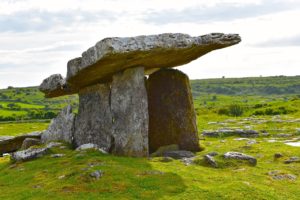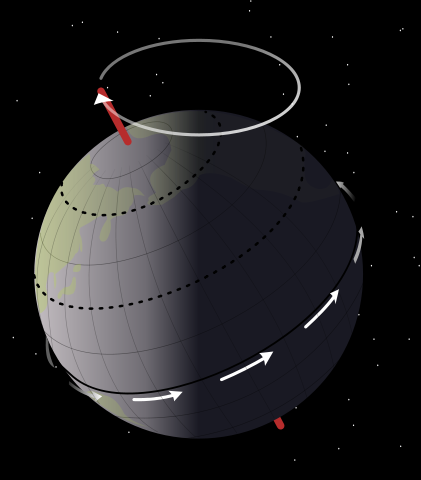| (18.16.12) 11.722 Northlight 85 (9.03 |

Length of this time unit: 25,000 years.
Rationale for time length
The length of the Genesis and Eon time scales coincide with the rise of the genus Homo and the rise of the dinosaurs. Setting calendar intervals related to these two events helps us better understand the history of our earth. Coincidentally, the factor between these two events is a factor of one hundred. So having the Epoch be one-one hundredths of the length of Genesis fits that pattern well.

Another notable coincidence is that the length of an Epoch, 25,000 years, is quite close to another interesting Earth cycle known as the the axial precession. This cycle is a rotation of the tilt of the Earth (indicated by the circle above the Earth in the illustration to the right). Imagine how different the constellations would look from the earth from each point of the circle. As the direction of Earth’s poles change over that long cycle, the view as seen from Earth makes it look like that the universe is slowly rotating backwards through the constellations. Really, it’s the Earth making the rotation.
There is much talk right now among astrologers about the Earth apparently moving from the Age of Pisces to the Age of Aquarius. The axial precession—currently estimated to be between 25,700 and 26,000 years in length but which has been slowly growing longer—is the length of time the Earth would appear to pass through the ages of all twelve signs of the zodiac.
(The Axial Precession will grow longer as the Moon orbits further and further away from the Earth. In 1.5 billion years the Axial Precession will be about 49,000 years long and in 2 billion years, the Axial Precession will be about 69,000 years long. This variability is why Earth Epic Calendar doesn’t use the length of the Axial Precession itself as a unit of time.)
Beginning of the current Epoch: 11,700 years before the year 2000 = 9701 BCE*
Rationale for setting the current Epoch at that date
Since the margin of error on Earth’s estimated age is plus or minus 50 million years, we have set the beginning of the most recent Eon and Genesis at times that are significant and convenient. We also set Epoch 0 of the current genesis where we deem it appropriate.
The beginning of the current Genesis began 311,700 years ago, around the oldest estimate of when Homo Sapiens is believed to have first evolved. That would put us in the midst of Epoch 12. So, the Epic Time Scale puts us in Eon 18, Genesis 16, Epoch 12.
But why begin the current Epoch at 9701 BCE? Arguably, the most significant event in human history prior to the modern era was the beginning of the Holocene Epoch. “Epoch” also happens to be the second shortest unit on the Geological Time Scale ranging in length from the current 11,700 years to 44 million years. (Note, 11,700 years before 2000 CE is actually 9701 BCE, not 9700 BCE because the current Gregorian Calendar has no zero, and skips from 1 CE* to 1 BCE.)
The Holocene Epoch is when the last glacial period (what many people mistakenly refer to as the Ice Age) ended, paving the way for the rapid development of human civilization. (Technically, we are still in an Ice Age–just one of many interim periods between glaciations which have been happening with the Quartenary Period that began 2.58 million years ago. Because of climate change, whether another glacial period will return within the upcoming tens or hundreds of thousands of years remains to be seen.) Within the Holocene is when human societies began to develop from nomadic hunter-gathering to agricultural settlements, from which cities and later empires developed.
The International Commission on Stratigraphy (ICS) set the official date of the beginning of the Holocene at 9701 BCE +/- 99 years based on data from around the world, but, in particular, ice core samples in Greenland, where the ice is 2-3 km deep. Examination of ice cores can provide hints of weather and other climate events going back in time, and when corroborated with other samples around the world, can give a good hint about global climate at the time.
Once again, the Earth Epic Calendar tells us a lot about our Earth history, and the history of humans.
*CE stands for Common Era and BCE* stands for Before Common Era. These are the same as AD and BC, preferred by those who prefer secular references to the date.
—> continue on the Calendar Tour to the Calendar Time Scales
<— Go back in the Calendar Tour to Genesis
(return to The Epic Time Scales)